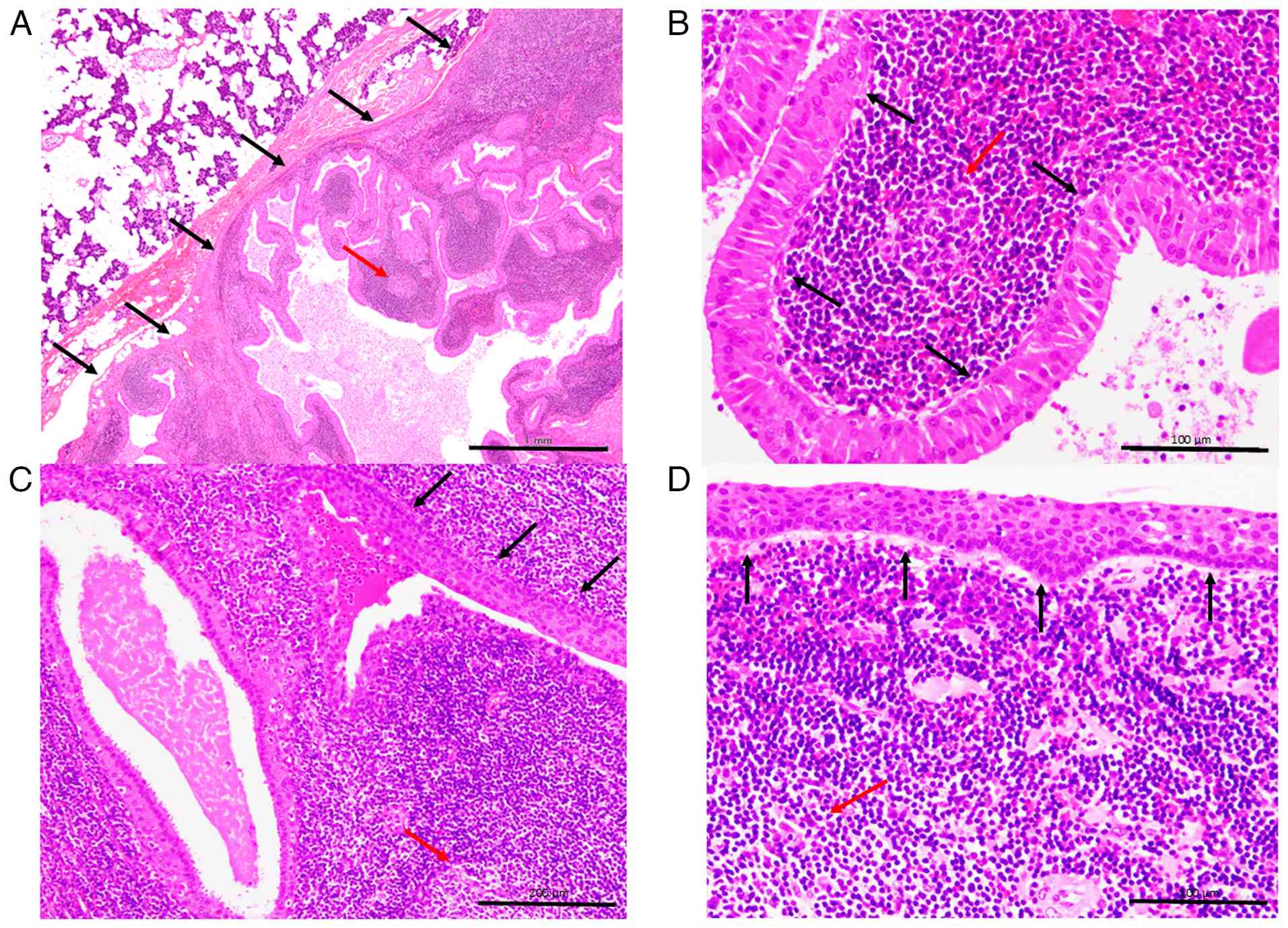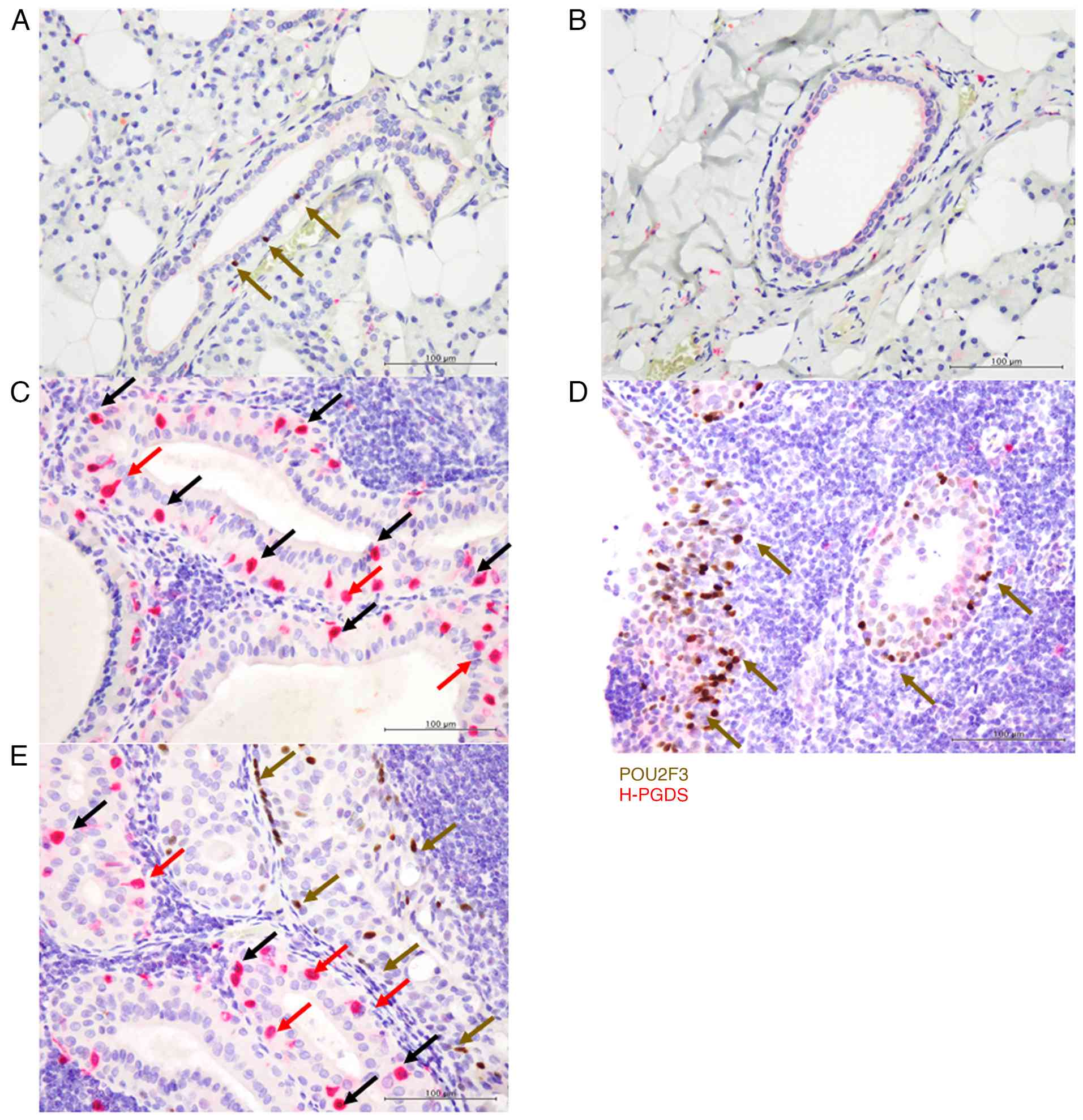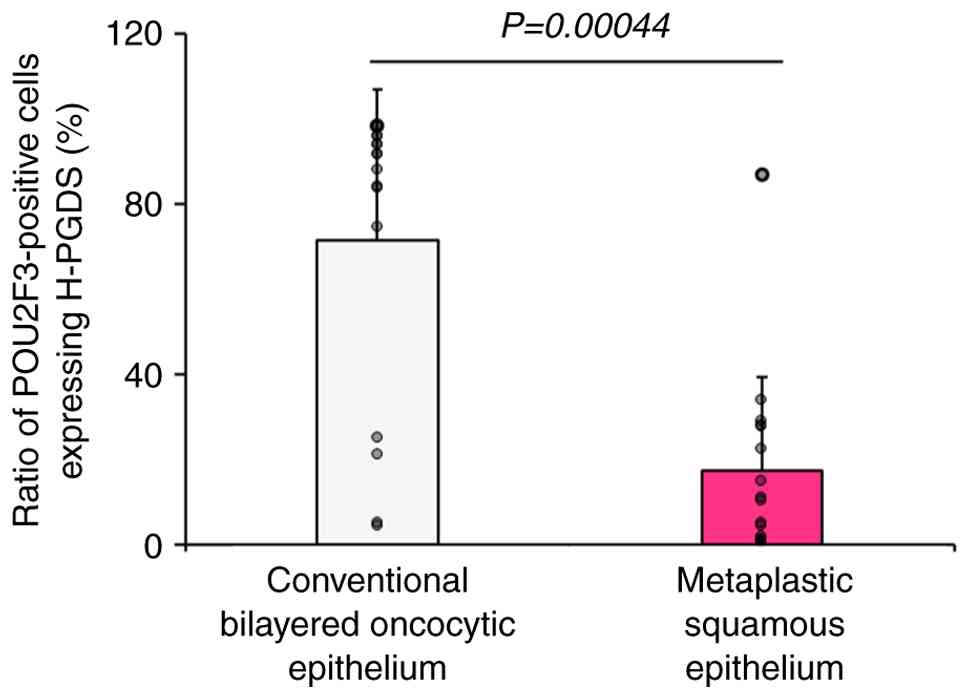|
1
|
Simpson RHW, Di Palma S, Faquin WC and
Pasricha S: Warthin tumour. In: WHO Classification of Tumours Head
and Neck Tumours. 5th edition. IARC Press; Lyon: pp. 173–175.
2024
|
|
2
|
Seifert G, Bull HG and Donath K:
Histologic subclassification of the cystadenolymphoma of the
parotid gland. Analysis of 275 cases. Virchows Arch A Pathol Anat
Histol. 388:13–38. 1980. View Article : Google Scholar : PubMed/NCBI
|
|
3
|
Billipp TE, Nadjsombati MS and von Moltke
J: Tuning tuft cells: New ligands and effector functions reveal
tissue-specific function. Curr Opin Immunol. 68:98–106. 2021.
View Article : Google Scholar : PubMed/NCBI
|
|
4
|
Gerbe F and Jay P: Intestinal tuft cells:
Epithelial sentinels linking luminal cues to the immune system.
Mucosal Immunol. 9:1353–1359. 2016. View Article : Google Scholar : PubMed/NCBI
|
|
5
|
Kotas ME, O'Leary CE and Locksley RM: Tuft
cells: Context- and tissue-specific programming for a conserved
cell lineage. Annu Rev Pathol. 18:311–335. 2023. View Article : Google Scholar : PubMed/NCBI
|
|
6
|
Schneider C, O'Leary CE and Locksley RM:
Regulation of immune responses by tuft cells. Nat Rev Immunol.
19:584–593. 2019. View Article : Google Scholar : PubMed/NCBI
|
|
7
|
Matsumoto I, Ohmoto M, Narukawa M,
Yoshihara Y and Abe K: Skn-1a (Pou2f3) specifies taste receptor
cell lineage. Nat Neurosci. 14:685–687. 2011. View Article : Google Scholar : PubMed/NCBI
|
|
8
|
Ohmoto M, Yamaguchi T, Yamashita J,
Bachmanov AA, Hirota J and Matsumoto I: Pou2f3/Skn-1a is necessary
for the generation or differentiation of solitary chemosensory
cells in the anterior nasal cavity. Biosci Biotechnol Biochem.
77:2154–2156. 2013. View Article : Google Scholar : PubMed/NCBI
|
|
9
|
Gerbe F, Sidot E, Smyth DJ, Ohmoto M,
Matsumoto I, Dardalhon V, Cesses P, Garnier L, Pouzolles M, Brulin
B, et al: Intestinal epithelial tuft cells initiate type 2 mucosal
immunity to helminth parasites. Nature. 529:226–230. 2016.
View Article : Google Scholar : PubMed/NCBI
|
|
10
|
Yamashita J, Ohmoto M, Yamaguchi T,
Matsumoto I and Hirota J: Skn-1a/Pou2f3 functions as a master
regulator to generate Trpm5-expressing chemosensory cells in mice.
PLoS One. 12:e01893402017. View Article : Google Scholar : PubMed/NCBI
|
|
11
|
Tavares Dos Santos H, Nam K, Maslow FM,
Small T, Galloway TLI, Dooley LM, Tassone PT, Zitsch RP III,
Weisman GA and Baker OJ: Tuft cells are present in submandibular
glands across species. J Histochem Cytochem. 70:659–667. 2020.
View Article : Google Scholar : PubMed/NCBI
|
|
12
|
Hoki M, Yamada Y, Hiratomo E, Hirata M,
Takeuchi Y, Yoshimatsu M, Kikuchi M, Kishimoto Y, Marx A and Haga
H: Expression of FOXI1 and POU2F3 varies among different salivary
gland neoplasms and is higher in Warthin tumor. Discov Oncol.
15:362024. View Article : Google Scholar : PubMed/NCBI
|
|
13
|
Ricciotti E and FitzGerald GA:
Prostaglandins and inflammation. Arterioscler Thromb Vasc Biol.
31:986–1000. 2011. View Article : Google Scholar : PubMed/NCBI
|
|
14
|
Seo MJ and Oh DK: Prostaglandin synthases:
Molecular characterization and involvement in prostaglandin
biosynthesis. Prog Lipid Res. 66:50–68. 2017. View Article : Google Scholar : PubMed/NCBI
|
|
15
|
Urade Y and Eguchi N: Lipocalin-type and
hematopoietic prostaglandin D synthases as a novel example of
functional convergence. Prostaglandins Other Lipid Mediat. 68–69.
375–382. 2002.PubMed/NCBI
|
|
16
|
Kanaoka Y and Urade Y: Hematopoietic
prostaglandin D synthase. Prostaglandins Leukot Essent Fatty Acids.
69:163–167. 2003. View Article : Google Scholar : PubMed/NCBI
|
|
17
|
Redensek A, Rathore KI, Berard JL,
López-Vales R, Swayne LA, Bennett SA, Mohri I, Taniike M, Urade Y
and David S: Expression and detrimental role of hematopoietic
prostaglandin D synthase in spinal cord contusion injury. Glia.
59:603–614. 2011. View Article : Google Scholar : PubMed/NCBI
|
|
18
|
DelGiorno KE, Chung CY, Vavinskaya V,
Maurer HC, Novak SW, Lytle NK, Ma Z, Giraddi RR, Wang D, Fang L, et
al: Tuft cells inhibit pancreatic tumorigenesis in mice by
producing prostaglandin D2. Gastroenterology.
159:1866–1881.e8. 2020. View Article : Google Scholar : PubMed/NCBI
|
|
19
|
Aoki R and Tanaka T: Pathogenesis of
Warthin's tumor: Neoplastic or non-neoplastic? Cancers (Basel).
16:9122024. View Article : Google Scholar : PubMed/NCBI
|
|
20
|
Mohri I, Eguchi N, Suzuki K, Urade Y and
Taniike M: Hematopoietic prostaglandin D synthase is expressed in
microglia in the developing postnatal mouse brain. Glia.
42:263–274. 2003. View Article : Google Scholar : PubMed/NCBI
|
|
21
|
Yamada Y, Simon R, Iwane K, Nakanishi Y,
Takeuchi Y, Yoshizawa A, Takada M, Toi M, Haga H, Marx A and Sauter
G: An exploratory study for tuft cells in the breast and their
relevance in triple-negative breast cancer: The possible
relationship of SOX9. BMC Cancer. 23:4382023. View Article : Google Scholar : PubMed/NCBI
|
|
22
|
Helliwell RJ, Keelan JA, Marvin KW, Adams
L, Chang MC, Anand A, Sato TA, O'Carroll S, Chaiworapongsa T,
Romero RJ and Mitchell MD: Gestational age-dependent up-regulation
of prostaglandin D synthase (PGDS) and production of PGDS-derived
antiinflammatory prostaglandins in human placenta. J Clin
Endocrinol Metab. 91:597–606. 2006. View Article : Google Scholar : PubMed/NCBI
|
|
23
|
Nevo S, Kadouri N and Abramson J: Tuft
cells: From the mucosa to the thymus. Immunol Lett. 210:1–9. 2019.
View Article : Google Scholar : PubMed/NCBI
|
|
24
|
Schütz B, Ruppert AL, Strobel O, Lazarus
M, Urade Y, Büchler MW and Weihe E: Distribution pattern and
molecular signature of cholinergic tuft cells in human
gastro-intestinal and pancreatic-biliary tract. Sci Rep.
9:174662019. View Article : Google Scholar : PubMed/NCBI
|
|
25
|
Storz P: Acinar cell plasticity and
development of pancreatic ductal adenocarcinoma. Nat Rev
Gastroenterol Hepatol. 14:296–304. 2017. View Article : Google Scholar : PubMed/NCBI
|
|
26
|
DelGiorno KE, Naeem RF, Fang L, Chung CY,
Ramos C, Luhtala N, O'Connor C, Hunter T, Manor U and Wahl GM: Tuft
cell formation reflects epithelial plasticity in pancreatic injury:
Implications for modeling human pancreatitis. Front Physiol.
11:882020. View Article : Google Scholar : PubMed/NCBI
|
|
27
|
Barr J, Gentile ME, Lee S, Kotas ME, de
Mello Costa MF, Holcomb NP, Jaquish A, Palashikar G, Soewignjo M,
McDaniel M, et al: Injury-induced pulmonary tuft cells are
heterogenous, arise independent of key type 2 cytokines, and are
dispensable for dysplastic repair. Elife. 11:e780742022. View Article : Google Scholar : PubMed/NCBI
|
|
28
|
McLean-Holden AC and Bishop JA: Low
molecular weight cytokeratin immunohistochemistry reveals that most
salivary gland Warthin tumors and lymphadenomas arise in
intraparotid lymph nodes. Head Neck Pathol. 15:438–442. 2021.
View Article : Google Scholar : PubMed/NCBI
|













